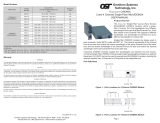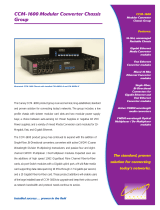Page is loading ...

OmniLight
®
5-Channel Single-Fiber CWDM MUX/DEMUX
USER MANUAL
5-Channel Single-Fiber CWDM Multiplexer/Demultiplexer Product Overview
The OmniLight half-size LGX
5-Channel Single-Fiber CWDM Multiplexer/Demultiplexer
(MUX/DEMUX) modules support ITU-T G.694.2 wavelengths between 1431nm to
1611nm in 20nm increments with a 1310nm Pass Band Port. An optional Optical Time
Domain Reectometer (OTDR) port is available which provides the ability to test the
integrity of the ber optic link without disturbing the wavelength channels.
OmniLight CWDM modules are protocol and rate transparent allowing different services
up to 10Gbps to be transported across the same common ber link.
The 5-Channel Single-Fiber MUX/DEMUX can be congured to operate as a 5-Channel
Single-Fiber MUX/DEMUX (Figure 2), a 10-Channel Single-Fiber MUX (Figure 3) or a
10-Channel Single-Fiber DEMUX (Figure 4).
Port Denitions
Figure 1: CWDM MUX/DEMUX
CWDM Channel Ports
The Channel Ports transmit and receive signals on specic CWDM wavelengths. The
Channel Ports are multiplexed onto and demultiplexed from the Common Port.
OTDR Port
The optional OTDR port provides the ability to test the integrity of the ber optic link by
connecting an external test equipment to the port. It operates at 1625nm to 1660nm.
1310 Pass Band Port
The 1310 Pass Band Port allows a uni-directional legacy 1310nm signal to pass through
the module on a reserved band (1270nm to 1350nm). The port can be used to combine
Page 1
an existing legacy 1310nm signal with up to 10 CWDM channels, allowing the CWDM
channels in the range of 1431nm to 1611nm to be overlaid on the same ber pair as
the existing 1310nm signal.
Common Ports
The Common Port transmits and receives the aggregated wavelengths connected to
the Channel Ports.
Figure 2: 5-Channel CWDM MUX/DEMUX
with 1310 Pass Band and Optional OTDR
Figure 3: 10-Channel CWDM MUX Figure 4: 10-Channel CWDM DEMUX
Installation
1. Carefully align the push rivets on the module with mounting holes on the chassis or
shelf corresponding with the desired opening. Once aligned, push the rivets into
mounting holes to lock the module in place.
2. Connect a single-mode, LC/APC single-mode ber cable between the Channel Port
of the module and the attached device. It is important to ensure that the wavelength
of the Channel Port matches the wavelength of the attached device. Connect all
Channel Ports in this manner. Ensure that the transmit (Tx) is attached to the
receive side of the device at the other end, and the receive (Rx) is attached to the
transmit side.
3. When overlaying an existing 1310nm legacy signal, connect the LC/APC single-
mode ber cable from the 1310 signal to the 1310 Pass Band Port on the module.
4. Depending on the network topology, the Common Ports support a single-mode
LC/APC ber cable. Connect these ports according to the network topology.
Page 2

Design Considerations
Port Units Signal Loss
1431 dB
Typical 4.4, Max 5.0
1451 dB Typical 4.0, Max 4.7
1471 dB Typical 3.7, Max 4.4
1491 dB Typical 3.4, Max 4.1
1511 dB Typical 3.1, Max 3.8
1531 dB Typical 2.8, Max 3.5
1551 dB Typical 2.5, Max 3.2
1571 dB Typical 2.2, Max 2.9
1591 dB Typical 1.9, Max 2.6
1611 dB Typical 1.6, Max 2.3
1310 Pass Band dB Typical 0.8, Max 1.0
OTDR dB Typical 1.4, Max 2.5
Note – Above specs includes connector loss
Detailed power/loss budget calculations should be performed for each ber optic link
in the network.
When calculating optical loss, ensure that the total loss, plus a safety factor (typically 3dB)
does not exceed the optical power budget. The optical power budget is the difference
between the transmitter optical output power and the receiver’s optical sensitivity. The
transmitter optical output power and receiver optical sensitivity values can be obtained
from the manufacturers of the respective equipment.
Page 3
Warranty
This product is warranted to the original purchaser against defects in material and
workmanship for a period of one (1) year from the date of shipment. During the warranty
period, Omnitron will, at its option, repair or replace a product which is proven to be defective
with the same product or with a product with at least the same functionality.
For warranty service, the product must be sent to an Omnitron designated facility, at Buyer’s
expense. Omnitron will pay the shipping charge to return the product to Buyer’s designated
US address using Omnitron’s standard shipping method.
Limitation of Warranty
The foregoing warranty shall not apply to defects resulting from improper or inadequate use
and/or maintenance of the equipment by Buyer, Buyer-supplied equipment, Buyer-supplied
interfacing, unauthorized modications or tampering with equipment (including removal of
equipment cover by personnel not specically authorized and certied by Omnitron), or
misuse, or operating outside the environmental specication of the product (including but
not limited to voltage, ambient temperature, radiation, unusual dust, etc.), or improper site
preparation or maintenance.
No other warranty is expressed or implied. Omnitron specically disclaims the implied
warranties of merchantability and tness for any particular purpose.
The remedies provided herein are the Buyer’s sole and exclusive remedies. Omnitron shall
not be liable for any direct, indirect, special, incidental, or consequential damages, whether
based on contract, tort, or any legal theory.
Environmental Notices
The equipment covered by this manual must be disposed of or recycled in accordance with
the Waste Electrical and Electronic Equipment Directive (WEEE Directive) of the European
Community directive 2012/19/EU on waste electrical and electronic equipment (WEEE)
which, together with the RoHS Directive 2011/65/EU, for electrical and electronic equipment
sold in the EU after July 1, 2006. Such disposal must follow national legislation for IT and
Telecommunication equipment in accordance with the WEEE directive: (a) Do not dispose
waste equipment with unsorted municipal and household waste. (b) Collect equipment
waste separately. (c) Return equipment using collection method agreed with Omnitron..
The equipment is marked with the WEEE symbol to indicate that it must be collected
separately from other types of waste. In case of small items the symbol may be printed only
on the packaging or in this manual. If you have questions regarding the correct disposal
of equipment go to www.omniton-systems.com/support or e-mail to Omnitron at intlinfo@
omnitron-systems.com.
040-05900-001C 10/17
Omnitron Systems Technology * 38 Tesla * Irvine, CA 92618
949.250.6510 tel * 949.250.6514 fax * www.omnitron-systems.com
©2017 Omnitron Systems Technology, Inc. OmniLight is a registered trademark of Omnitron Systems Technology, Inc. LGX is a registered
trademark of AT&T. Trademarks are owned by their respective companies. Specications subject to change without notice. All rights reserved.
/












